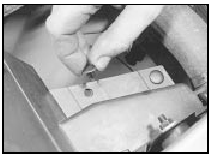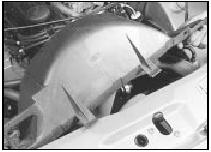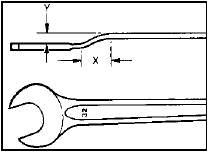Thermo-viscous cooling fan (SOHC models) - removal and refitting
Removal
1 Disconnect the battery negative lead.
2 Remove the four retaining clips and unscrew the two retaining screws, then withdraw the upper section of the fan shroud (see illustrations).

12.2a Remove the retaining clips followed by the screws . . .

12.2b . . . and withdraw the upper section of the fan shroud
3 The cooling fan hub nut must now be unscrewed from the coolant pump drive flange. A thin cranked 32.0 mm (1.25 in AF) spanner with a jaw thickness not exceeding 5.0 mm (0.2 in) will be required (see illustration). Alternatively, if two of the coolant pump pulley bolts are removed, a normal thickness spanner can be used. Note that the fan hub nut has a left-hand thread, (ie it is undone in a clockwise direction.) If the pulley turns as the nut is undone, remove the drivebelt, and clamp an old drivebelt round the pulley to restrain it, using self-locking pliers. Tap the spanner with a mallet if required to remove the nut.

12.3 Modified spanner required for removing the thermo-viscous cooling fan X
= 25.0 mm (1.0 in) Y = 12.0 mm (0.5 in)
4 If required, the fan blades can be separated from the fan hub by unscrewing the four securing bolts.
Refitting
5 Refitting is a reversal of removal, but where
applicable, take care not to overtighten the
bolts securing the fan blades to the fan hub,
as thread damage may require the whole unit
to be renewed. Where applicable, refit and
tension the drivebelt.
See also:
Radiator grille - removal and refitting
Pre-1988 models
Removal
1 The grille is held in position by four spring
clips (see illustration).
10.1 Radiator grille spring clip - pre-1988 models
2 Once these clips are released, the grille ...
Fuel system - depressurising
Warning: The fuel system will
remain pressurised after the
engine is switched off. Comply
with relevant safety precautions
during this operation and refer to the
“Safety First” Section at the beg ...
Front hub carrier - removal and refitting
Note: A balljoint separator tool will be
required for this operation.
Removal
1 Loosen the relevant front roadwheel nuts,
apply the handbrake, jack up the front of the
vehicle and support on axle ...
